Learn how to effectively track Drift interactions in Google Analytics so you can get greater visibility of your customer journey.
Live chat is a key channel for lead capture and customer engagement. It allows you to connect with your website visitors in real-time, answer questions and support them with queries.
By tracking Drift conversions in Google Analytics, you can begin to understand how online chat supports your other marketing channels and campaigns.
You’ll get a single source of truth when it comes to understanding what’s working and what isn’t.
In this blog, we’ll discuss:
💡 Pro Tip
Track which channels, campaigns and keywords generate the most valuable live chat conversions and make informed decisions to drive more qualified leads and sales.
Download our guide on tracking live chat conversions and conversations.
Drift is a valuable live chat tool that allows companies to tackle lead and customer queries. According to a study by Kayako, 79% of businesses said that implementing live chat resulted in increased customer loyalty, sales and revenue.
Installing a chatbot feature like Drift allows marketers to drive more qualified leads and reduce conversion time of prospects into leads and sales.
Related: Best live chat tools to try
Let’s explore how Drift can improve your marketing effectiveness:
Marketers can use Drift to share further information with their target audience navigating around the website. For example, we have an article on marketing attribution tools and software. If, or when, a visitor lands on the blog, they’re sent a message from Drift to learn more about the topic by downloading the eBook on closed-loop marketing attribution. By using Drift to offer additional information, you can show the reader that you care about their interests and drive more top of the funnel leads in the process.
Generally, potential buyers will have questions about your products or services. With Drift, you can answer all their queries in real-time to help them reach buying decisions and move through the funnel more efficiently.
Website visitors who use live chat are worth 4.5 times than the ones who don’t. Using automated messaging, specifically during the onboarding stage, companies can stay engaged with customers to improve satisfaction and retention rates.
Our recent survey of over 200 marketers found that 53% of marketers who use live chat as a conversion tool struggle to track it. And this isn’t the only disadvantage to using Drift or another online chat tool:
53% of marketers using live chat struggle to track it. But what does that mean? Well, while live chat tools often have a whole host of analytics, it doesn’t integrate with your website and your apps to allow you to view closed revenue.
Customer journeys are often long and complex. Users will often visit your website across multiple sessions, channels and devices. As a result, it makes it more difficult for marketers to track the end-to-end impact of marketing campaigns. This affects live chat too. Without a full customer journey view, you can’t see how conversations and conversions from live chat impact new leads and closed deals.
Drift enquiries and lead generation activity are often measured in separate platforms and managed by different teams. Since marketers can’t properly track live chat on their own, they can’t see which activities are driving the most qualified leads in Drift.
Sending Drift activity to your CRM is the most effective way to keep track of all your leads, sales, support or any other issues associated with your customers. However, like most apps,it can be tricky to get the right data out of Drift and into your CRM. Many companies opt for a designated CRM manager to bridge this gap. Not only is this time consuming, but this method often results in misspellings, statistical errors and incorrect contact details.
Do any other those points sound familiar? By tracking Drift conversions properly you can get the data you need where you need it most. So, you can view all your lead data in your CRM and the conversions created in Google Analytics. Let’s get stuck into how to make that happen.
Tracking Drift events in Google Analytics is simple—when you know how to do it. Below is a basic guide on how to track Drift events in Google Analytics.
Step 1: Head to Drift’s app store and select Google Analytics from the menu.
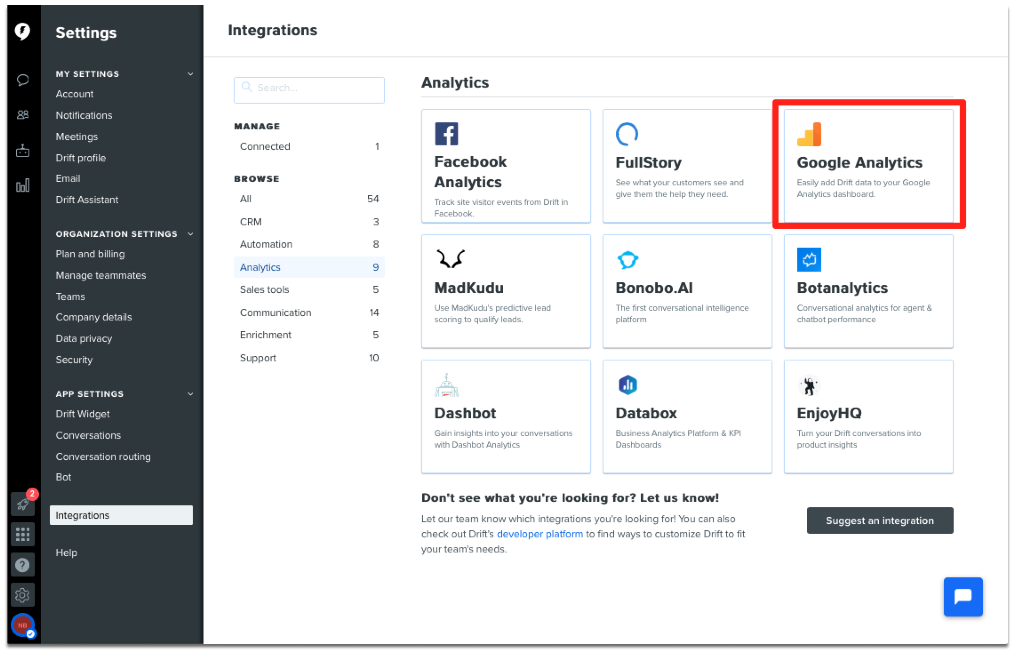
Step 2: Install the Google Analytics app. Connect to Google Analytics to begin the integration.
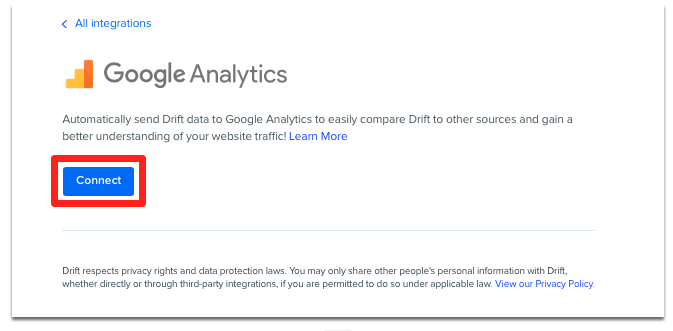
Step 3: If you’re already logged into Google Analytics, then you can simply authorize access to your account. If not, go to your Google Analytics account and copy your tracking ID. If you’re not sure how to do this, then follow these steps.
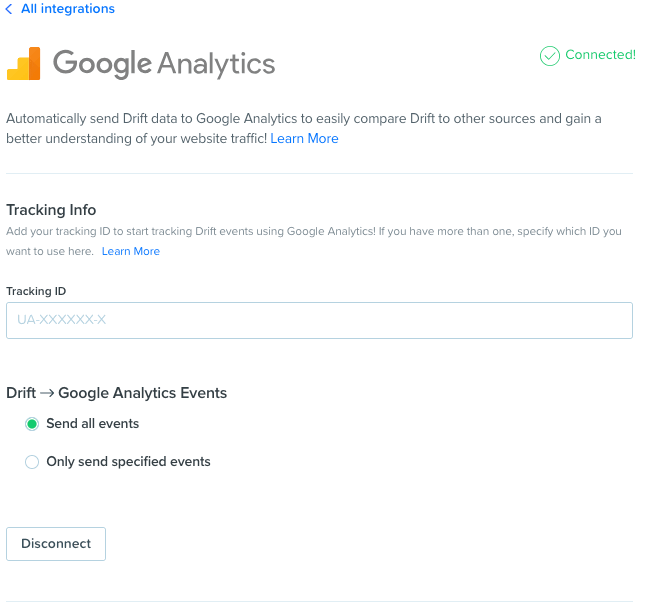
Remember, Drift defaults to sending all conversion types over to your Google Analytics. If you want to limit this, you can edit this in Google Analytics.
To see your Drift interactions in Google Analytics, head to Events in the Behaviour tab.

If you want to go one further and see how your pages and channels are driving Drift events as a goal, then you’ll need to set these up yourself.
In Google Analytics, select the Admin gear icon and click into the Goals section. Then, click + New Goal.
Name your goal and choose “Event” as the type. Click Continue.
Set the category as “Equals to” and “Drift Widget”.
Based on the event you’re configuring your goal with, Based on which action you want to trigger a goal based off of, you’ll use Action Equal To “Chat Started”, “Email Captured”, “Meeting Booked” etc.
Keep the Label and Value fields blank. Lastly, you’ll want to turn off the toggle that reads “Use the Event Value as the Goal Value for the conversion” and set any monetary value greater than 0.
It should look like this.
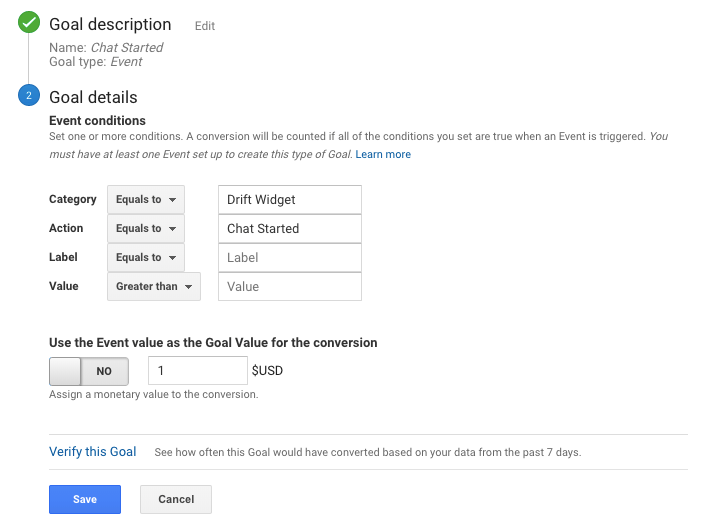
Click save and you’re ready to go!
But what exactly is this telling you? While you can start to get a picture of new live chat sessions influenced by marketing channels and campaigns, what is it really telling you?
You can’t see the quality of these leads. Keep reading to find out how to attribute closed revenue in your CRM back to your Drift events in Google Analytics.
Tracking revenue is essential to understanding which marketing channels and campaigns are driving the best quality leads.
And with marketing attribution, you can track revenue for every lead, no matter how they convert.
Tying your closed revenue back to your Drift events in Google Analytics will give you the data you need to improve your campaigns and ultimately, drive more sales.
By connecting Drift leads to your CRM and Google Analytics, you’ll be able to effectively track which channels, campaigns and keywords generate the most valuable online conversations.
To enrich your Google Analytics with revenue activity, you’ll need to invest in a solution such as Ruler Analytics. The following steps are how to match Drift leads with revenue from your CRM in Google Analytics:
First and foremost, Ruler will ensure that any data is captured on a visitor level so that the system can match any leads, conversion or sales back to the marketing touchpoints generated by them, across multiple channels, ads and keywords.
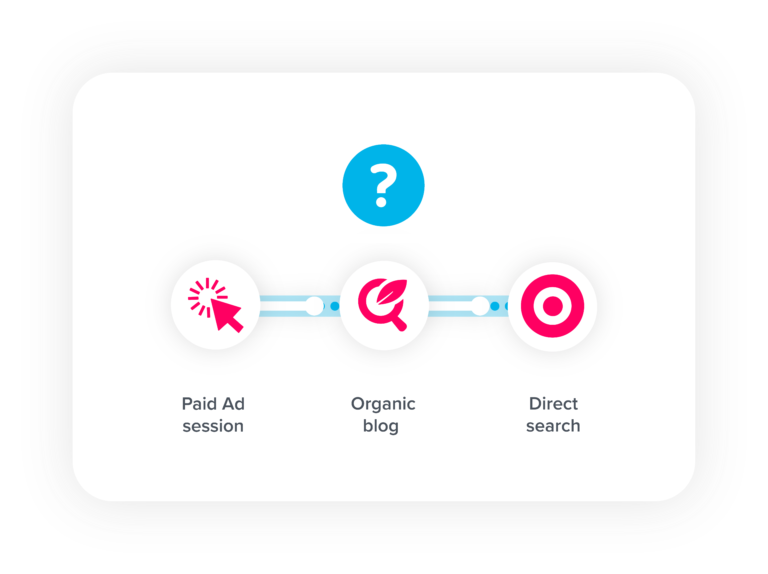
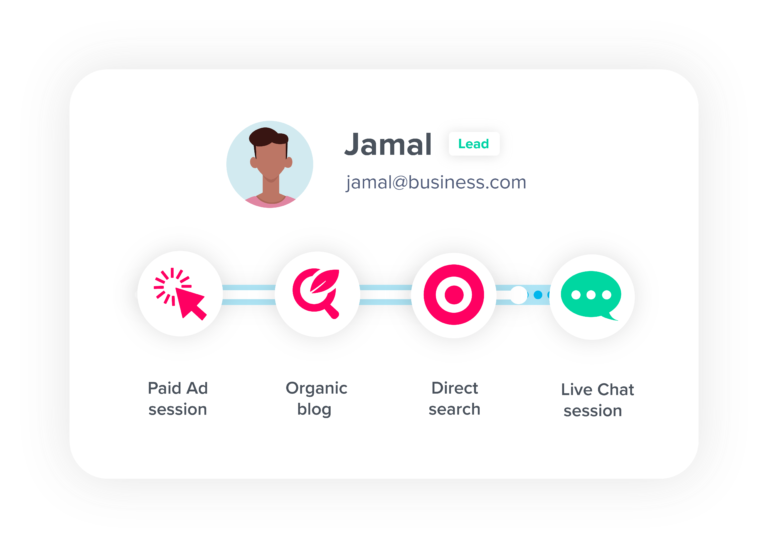
When an anonymous visitor converts into a lead via Drift, Ruler matches their conversion details to their marketing touchpoints.
Next, Ruler will pass the conversion data it’s collected to your CRM. Your sales team can see what specific products, services, or features users interacted with before converting into a lead.
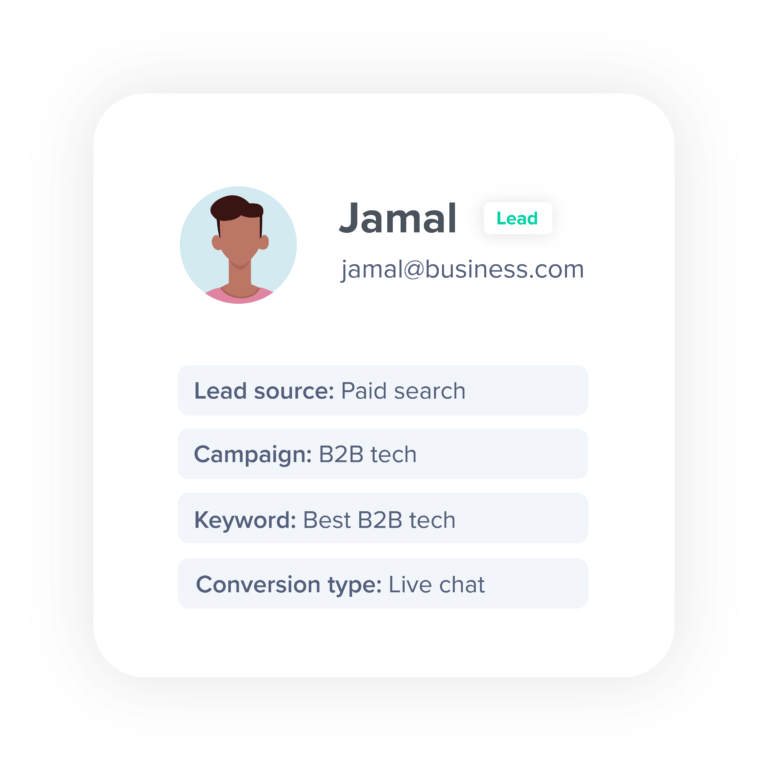
If or when the Drift leads closes into revenue, whether it be a week, month or year, the value from the sale will get sent back to the Ruler Analytics dashboard so that you can measure the impact of your marketing sources, campaigns, keywords and ads based on monetary values and not just conversions.
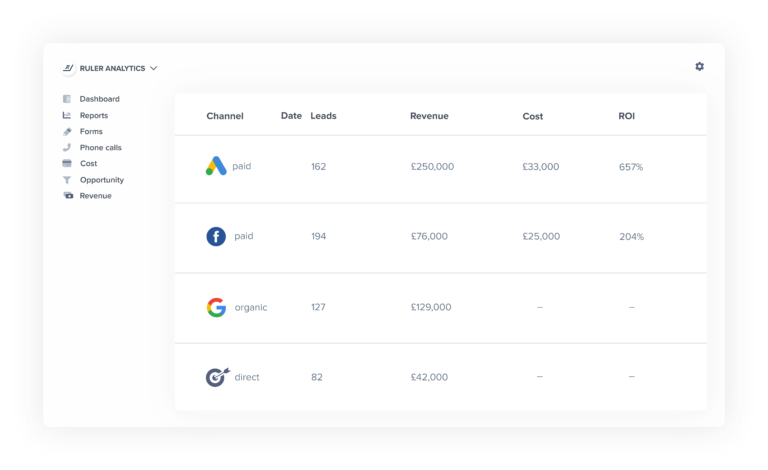
Ruler can automatically send the value of the sale to your Google Analytics and Google Ads account, allowing you to report and view revenue data for Drift throughout the Google Analytics reporting suite.
Related: How to link your CRM with Drift
Side Note: Ruler Analytics can also send webform and phone call revenue to Google Ads, Microsoft Advertising and Facebook conversions. Go to the integrations page to learn more about those.
Tracking Drift activity with Ruler Analytics provides a single source of truth on which products or services generate the most valuable conversations. Here are more benefits to consider when sending Drift conversions to Google Analytics:
Provide your sales team with greater intelligence on leads and conversions. With full visibility of the buying process, salespeople can follow customers and move them further along the buyer journey more effectively with content tailored towards their interests and needs.
Identify which pages on your website lead to the most successful conversations.
Understand which keywords and campaigns drive the most valuable chats and reallocate budget to drive higher ROI.
Related: How to integrate Drift with Google Ads
Using Ruler Analytics is easy and intuitive, and integrates with the tools you use every day in a few simple steps.
If you use a live chat tool like Drift anywhere in your marketing arsenal, then you need to be properly tracking it. Without a clear understanding of your revenue growth from your marketing channels and conversion tools, you’re missing key data that could help you optimise your marketing and drive more revenue.
Ruler Analytics is easy to use and easy to install meaning you can get started with tracking live chat, form fills and phone calls straight away.
Want to know more about tracking Drift leads and CRM revenue in Google Analytics? Book a demo today and learn more about the possibilities of Ruler Analytics.